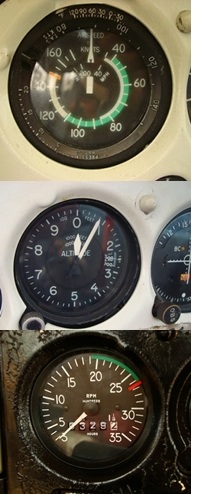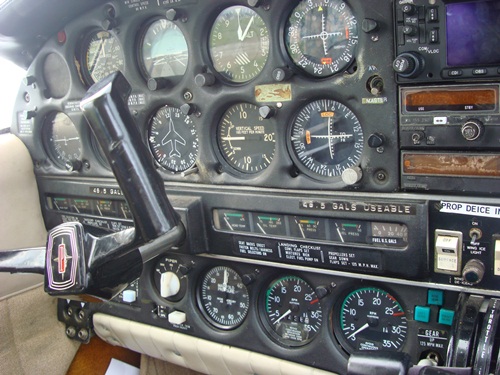
VFR dan IFR adalah aturan untuk terbang, sedangkan instrumen apa saja yang dibutuhkan dalam setiap penerbangan tersebut ada dalam aturannya masing-masing. Tautan untuk pengenalan VFR dan IFR ada di bagian paling bawah dari tulisan ini. Untuk membahas perangkat apa sajakah yang diperlukan untuk terbang dengan aturan VFR dan IFR mari kita buka CASR part 91 ayat 205. CASR yang saya miliki pada waktu membuat tulisan ini adalah CASR 91 Amdt. 03/24 Agustus 2011 yang bisa anda download di website hubud untuk mendapatkan versi terbarunya. Tautannya juga dapat anda temukan di bawah tulisan ini.
91.205 Powered Civil Aircraft with Standard Category Indonesian Airworthiness Certificates: Instrument and Equipment Requirements
 (b)Visual flight rules (day). For VFR flight during the day, the following instruments and equipment are required:
(b)Visual flight rules (day). For VFR flight during the day, the following instruments and equipment are required:
- (1) Airspeed indicator.
- (2) Altimeter.
- (3) Magnetic direction indicator.
- (4) Tachometer for each engine.
- (5) Oil pressure gauge for each engine using pressure system.
- (6) Temperature gauge for each liquid cooled engine.
- (7) Oil temperature gauge for each air cooled engine.
- (8) Manifold pressure gauge for each altitude engine.
- (9) Fuel gauge indicating the quantity of fuel in each tank.
- (10) Landing gear position indicator, if the aircraft has a retractable landing gear.
Selain dari instrumen yang dibutuhkan di atas, ada perangkat lain yang harus ada agar pesawat boleh terbang:
 (11) If the aircraft is operated for hire over water and beyond power off gliding distance from shore, approved flotation gear readily available to each occupant and at least one pyrotechnic signaling device. As used in this section, "shore" means that area of the land adjacent to the water which is above the high water mark and excludes land areas which are intermittently under water.
(11) If the aircraft is operated for hire over water and beyond power off gliding distance from shore, approved flotation gear readily available to each occupant and at least one pyrotechnic signaling device. As used in this section, "shore" means that area of the land adjacent to the water which is above the high water mark and excludes land areas which are intermittently under water.
Jika pesawat disewakan dan terbang di atas air dengan jarak lebih dari kemampuan glidingnya, maka untuk setiap penumpang wajib disediakan sebuah pelampung dan juga wajib untuk membawa paling tidak satu buah alat pyrotechnic signal yang bisa memberi sinyal dalam keadaan darurat di air. Hanya patut diingat alat pyrotechnic signal ini bisa menimbulkan resiko bahaya kebakaran jika tidak diperlakukan dengan hati-hati.
(12) An approved safety belt with an approved metal-to-metal latching device for each occupant 2 years of age or older.
 (13) For small civil airplanes manufactured after [27 December 1993], an approved shoulder harness for each front seat. The shoulder harness must be designed to protect the occupant from serious head injury when the occupant experiences the ultimate inertia forces specified in Part 23 of the CASRs. Each shoulder harness installed at a flight crewmember station must permit the crewmember, when seated and with the safety belt and shoulder harness fastened, to perform all functions necessary for flight operations. For purposes of this paragraph
(13) For small civil airplanes manufactured after [27 December 1993], an approved shoulder harness for each front seat. The shoulder harness must be designed to protect the occupant from serious head injury when the occupant experiences the ultimate inertia forces specified in Part 23 of the CASRs. Each shoulder harness installed at a flight crewmember station must permit the crewmember, when seated and with the safety belt and shoulder harness fastened, to perform all functions necessary for flight operations. For purposes of this paragraph
(14) An emergency locator transmitter, if required by Section 91.207.
(15)For normal, utility, and acrobatic category airplanes with a seating configuration (not including pilot seats) of 9 or less, manufactured after [date to be determined], a shoulder harness for
(i) Each front seat that meets the requirements of Part 23 of the CASRs in effect on [date to be determined];
(ii) Each additional seat that meets the requirements of Part 23 of the CASRs.
(16) For rotorcraft manufactured after September 16, 1992, a shoulder harness for each seat that meets the requirements of Part 27.2 and Part 29.2.
Link:
Peraturan Keselamatan
Sumber gambar: koleksi ilmuterbang.com, brosur FAA dan Transport Canada



